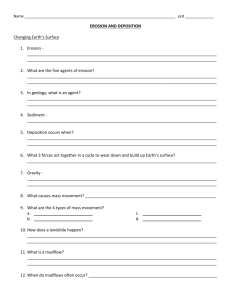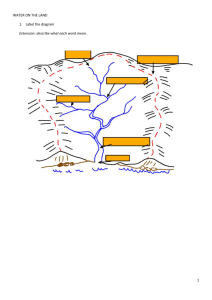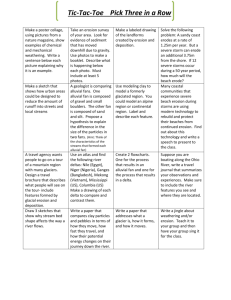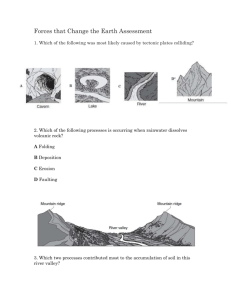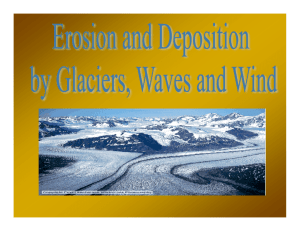Notes on Rivers
advertisement
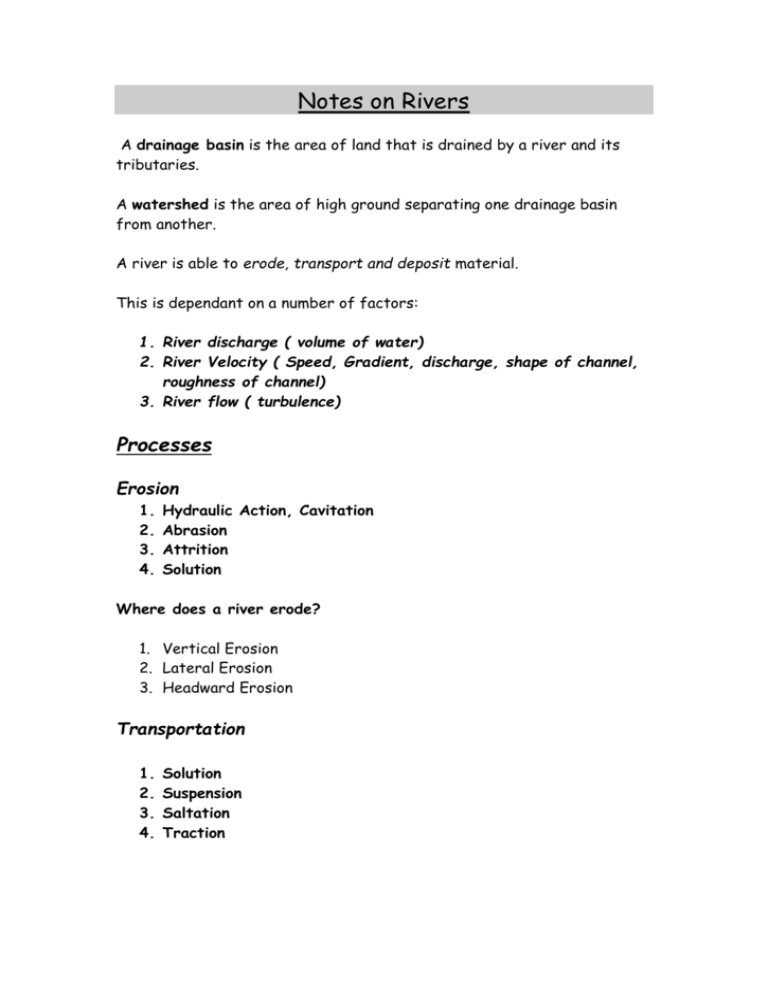
Notes on Rivers A drainage basin is the area of land that is drained by a river and its tributaries. A watershed is the area of high ground separating one drainage basin from another. A river is able to erode, transport and deposit material. This is dependant on a number of factors: 1. River discharge ( volume of water) 2. River Velocity ( Speed, Gradient, discharge, shape of channel, roughness of channel) 3. River flow ( turbulence) Processes Erosion 1. 2. 3. 4. Hydraulic Action, Cavitation Abrasion Attrition Solution Where does a river erode? 1. Vertical Erosion 2. Lateral Erosion 3. Headward Erosion Transportation 1. 2. 3. 4. Solution Suspension Saltation Traction Deposition occurs when: 1. Velocity is reduced 2. Discharge is reduced 3. Load is increased Upper course / Youthful Landforms/ Torrent Stage Vertical erosion is dominant. Discharge (volume) is small, gradient is steep. V-Shaped valleys A narrow, steep-sided valley Processes = Vertical erosion, Hydraulic Action, Abrasion, Weathering, Mass Movement Example = River Moy, River Slaney Interlocking Spurs Are sections of land that jut (stick) out as the river follows a zigzag course, flowing around areas of resistant rock. Waterfalls An interruption in the river profile, water makes a vertical drop. They develop where the river meets a band of less resistant rock after flowing over hard or more resistant rock. Forms as a result of differential erosion. As waterfalls retreat steep sided gorges are formed. A gorge is a deep narrow, steep sided valley. Example: River Shannon near Killaloe Processes = Hydraulic Action. Abrasion, Differential erosion, undercutting and retreat Examples = Torc Waterfall in Killarney, Aasleagh Falls near Killary Harbour Middle course / Mature Landforms Lateral erosion becomes dominant. Valley floor becomes wider and valley sides are less steep as a result of continued weathering and mass movement Meanders A series of gentle curving loops in the river Processes = Lateral erosion, hydraulic action. Abrasion. Slumping, Deposition, Corkscrew Flow Pools ( deep) and Riffles (shallows) occur along the bed of a river, these create currents, and water flows side to side (like a snake). This is called corkscrew flow. River Beach / point bar….inside bend River cliff…………….outer bends Flood Plain Is the wide flat floor of the river valley which flood following periods of heavy rainfall. End of flood plain is marked by a bluff point. Has very gentle gradient. On an OS map no contours will be present on both banks of the river. Braided Streams Occurs when a river breaks up into a series of interconnected channels. Due to load of river exceeding the river’s ability to transport it Processes: erosion, deposition and braiding. Lower Course / Old Stage of River / Plain Stage Process of erosion has practically stopped. Deposition is dominant. The valley floor is very wide and flat. The gradient is very gentle Oxbow Lakes / Cut off Horse shoe shaped lakes Processes = Lateral Erosion, hydraulic action, abrasion and deposition Example = Lower course of River Shannon Levees Are ridges that run parallel to the river, built up over time by successive flooding Processes = Flooding, Loss of energy and deposition, aggradation Example = Sections of River Moy Delta Is a flat area of alluvium when a river enters a big body of water like a lake ( Lacustrine Delta, Glendalough) or the sea (Marine Delta, Mississippi and Nile), enters an estuary ( Estuarine Delta, River Shannon) River must be carrying a very large load, and the ability of the sea to remove the load must be less then the amount of load deposited Processes = Loss of energy, flocculation (sediment coagulates (sticks together on contact with the seawater and settles rapidly), Sorting and deposition. Changes in Base Level Isostatic Movement Land level rises relative to the sea How? Uplift of landmass Weight of Glacial Ice being removed Eustatic movement Sea level falls relative to the land How? Occurs at the beginning of an Ice Age ( water freezes) Effect of River Land emerges from the sea Gradient steepens Increase in river energy Rate of erosion increases This renewed capacity to erode is called REJUVENATION. Forms a new river profile The point at which new profile meets old profile is called a Knick point Landforms Paired terraces Incised Meanders Drainage Patterns Dendritic Trellised Rectangular Parallel Radial Absence Deranged




